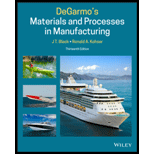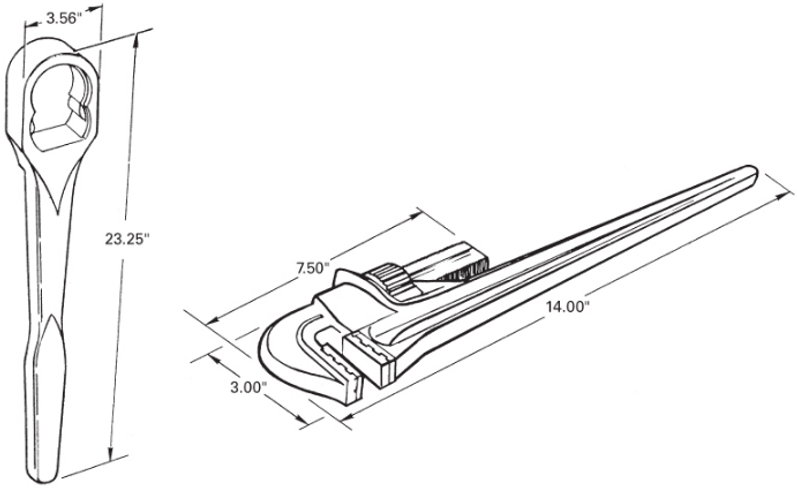
Figure 20.A depicts the handles of two large wrenches, ratchet wrench and a pipe wrench. These components are traditionally forged from a ferrous alloy, or made from a cast steel or cast iron. For various reasons, alternative materials may be desired. The ratchet wrench is quite long, and reduced weight may be a reasonable desire. Both of these tools could be used in areas, such as a gas leak, where a non-sparking safety tool would be required. Current specifications for the ratchet handle call for a yield strength in excess of 50 ksi and a minimum of 2% elongation in all directions to ensure prevention of brittle fracture. The pipe wrench most likely has similar requirements.

FIGURE 20.A Handle segment of a large ratchet wrench and components of a pipe wrench.
- Could a plastic or composite material be used to make a quality product with these additional properties? (NOTE: Metal jaw inserts can be used in the pipe wrench, enabling the other components to be considered as separate pieces.)
- If so, how would you propose to manufacture the new handles?
Want to see the full answer?
Check out a sample textbook solution
Chapter 20 Solutions
Degarmo's Materials And Processes In Manufacturing
Additional Engineering Textbook Solutions
Fluid Mechanics: Fundamentals and Applications
Engineering Mechanics: Statics & Dynamics (14th Edition)
Fundamentals Of Thermodynamics
Machine Tool Practices (10th Edition)
Manufacturing Engineering & Technology
Engineering Mechanics: Statics
- Consider the red aluminum tool holder shown in Figure 4. Your job shop has been contracted to make 10,000 pieces this year, with possibility of making 20,000 more each year in the future. Consider the process options below, which option is the best? a) using die casting, cast the holder anodizing the holder to red color b) using injection molding, mold the holder without hole using a mill or drill press, cut the hole anodizing the holder to red color c) using sand mold, cast the holder without hole using a mill, cut all planar surfaces (smooth surfaces) using a mill or drill press, cut the hole anodizing the holder to red color d) using a hacksaw, cut a piece of 3"X3" bar stock to length using a mill, cut all planar surfaces using a mill or drill press, cut the hole anodizing the holder to red colorarrow_forwardCoupling will be used in the drive mechanism of the roles used in the Continuous Casting plant. The moment to be transmitted is high, the transmission distance is about 1500 mm, and there are fluctuations in the bending direction. Which type of coupling is best suited to absorb these fluctuations? Explain broadly the features of this coupling. Draw it schematically and explain the working principle.arrow_forwardWhat manufacturing processes do you think were applied? Or what information be needed about the fabrication of this piece?arrow_forward
- Casting is a manufacturing process in which a liquid material is usually poured into a mold, which contains a hollow cavity of the desired shape, and then allowed to solidify. You are given a task to fabricate an engine block. In your own words, explain how to fabricate it using any suitable four types of processes which can be used and discuss the benefits of each processesarrow_forwardWhat would ne faster to produce a large quantity of these boxes? Batch production or constinous production? Explain whyarrow_forwardWhat is the importance of the glass box approach technique?arrow_forward
- describe and explain each steparrow_forwardEXPLAIN WHAT IS PROTOTYPE BY FIGURE AND WHY IS IMPORTANT ? EXPLAIN WHICH FACTORS TO BE CONSIDERED OF SIZING THE DESIGN PARTS ? EXPLAIN WHICH FACTORS TO BE CONSIDERED IN MATERIALS SELECTION BY FIGURES ?arrow_forwardExplain what is engraving. When was this printing method invented? How does an artist create this particular type of print? what are the steps involved?arrow_forward
 Elements Of ElectromagneticsMechanical EngineeringISBN:9780190698614Author:Sadiku, Matthew N. O.Publisher:Oxford University Press
Elements Of ElectromagneticsMechanical EngineeringISBN:9780190698614Author:Sadiku, Matthew N. O.Publisher:Oxford University Press Mechanics of Materials (10th Edition)Mechanical EngineeringISBN:9780134319650Author:Russell C. HibbelerPublisher:PEARSON
Mechanics of Materials (10th Edition)Mechanical EngineeringISBN:9780134319650Author:Russell C. HibbelerPublisher:PEARSON Thermodynamics: An Engineering ApproachMechanical EngineeringISBN:9781259822674Author:Yunus A. Cengel Dr., Michael A. BolesPublisher:McGraw-Hill Education
Thermodynamics: An Engineering ApproachMechanical EngineeringISBN:9781259822674Author:Yunus A. Cengel Dr., Michael A. BolesPublisher:McGraw-Hill Education Control Systems EngineeringMechanical EngineeringISBN:9781118170519Author:Norman S. NisePublisher:WILEY
Control Systems EngineeringMechanical EngineeringISBN:9781118170519Author:Norman S. NisePublisher:WILEY Mechanics of Materials (MindTap Course List)Mechanical EngineeringISBN:9781337093347Author:Barry J. Goodno, James M. GerePublisher:Cengage Learning
Mechanics of Materials (MindTap Course List)Mechanical EngineeringISBN:9781337093347Author:Barry J. Goodno, James M. GerePublisher:Cengage Learning Engineering Mechanics: StaticsMechanical EngineeringISBN:9781118807330Author:James L. Meriam, L. G. Kraige, J. N. BoltonPublisher:WILEY
Engineering Mechanics: StaticsMechanical EngineeringISBN:9781118807330Author:James L. Meriam, L. G. Kraige, J. N. BoltonPublisher:WILEY





